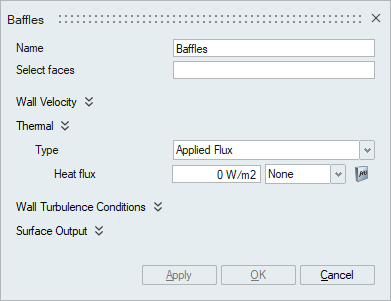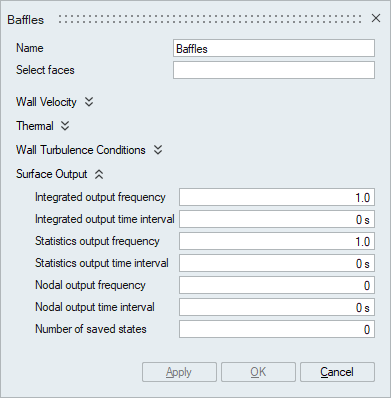Baffles
![]()
Baffles
This panel is used to define a baffle boundary condition in a flow problem. Baffle is required when there are internal surfaces that require two boundary conditions that is, cases that include baffles, sliding mesh, thermal interfaces. It can be applied on faces/face groups of volume meshed bodies.

Description
Select faces
The select faces option is used to select the faces/face groups that needs to be defined as baffle.
Specify Contact Angle
Wall Velocity
The velocity boundary condition for a wall type may be specified in six different ways, as determined by Wall Velocity Type. A value of Match Mesh Velocity is the default and requires no further data.The cartesian, cylindrical, spherical and normal wall velocity types allow the wall velocity to be specified in different local coordinate systems.
A wall velocity type of cartesian uses X, Y and Z velocities to impose boundary conditions in the global coordinate system. The Multiplier option can be used to specify time varying values.
A wall velocity type of cylindrical sets boundary conditions on the axial, radial, and tangential components of the velocity in a cylindrical coordinate system. The Define Axis can be used to specify the axis of the cylinder.A wall velocity type of spherical imposes a given boundary condition on the radial component of the velocity in a spherical coordinate system and zero boundary conditions on the other two components. The Sphere center needs to be specified in this case.
A wall velocity type of Normal imposes a given boundary condition on the component of the velocity normal to the surface and zero boundary conditions on the other two components.Thermal
The Thermal option becomes available in the Wall panel when the Heat Transfer option is enabled in the Solutions panel.
- Temperature : To specify temperature on the wall faces, the type should be selected as Temperature and the value should be specified in the Temperature option. The Multiplier option can be used to specify time varying values.
- Applied Flux : To specify Flux on the wall faces, the type should be selected as Applied Flux and the value should be specified in the Heat flux option. The Multiplier option can be used to input scaled values or specify time varying values.
- Convection :To specify convection on the wall faces, the type should be selected as Convection and the Heat transfer coefficient and Reference Temperature values should be specified. The Multiplier option can be used to input scaled values or specify time varying values.
Wall Turbulence Conditions
This option is used to specify a turbulent boundary layer for the wall.
- None
The None option should be selected when no wall modeling is required. When this option is set, the surface does not participate in the wall distance calculation for turbulence and no wall modeling is performed.
- Low Reynolds Number
The Low Reynolds number model is used when the Reynolds number of the flow is low and the grid near the wall is fine enough to resolve the flow. It utilizes special damping functions to solve the turbulence momentum equations near the wall. The damping functions substantially reduce the grid number requirement as compared to those needed in their absence.
Wall FunctionHigh Reynolds number flows on the contrary requires a large number of grid points to accurately resolve the flow at the wall which becomes computationally expensive. The Wall function turbulence wall type significantly reduces the computational requirements by introducing a function to bridge the near wall region. In which case, very refined grid is not required for wall function.
Running Average Wall FunctionThe Running Average wall function is similar to wall function but it utilizes the running average variables.
Roughness heightRoughness height is the average wall roughness height and is used with Low Reynolds number, Wall function and Running average wall function turbulence wall types.
Wall function heat flux factorIt is a constant factor used to scale the turbulent thermal conductivity within the first element off the wall. This is used with Wall function and Running average wall function turbulence wall type.
Surface Output
Surface Output specifies the output parameters for a boundary face.

- Integrated output frequency
Time step frequency at which the integrated surface quantities are output. If zero, this option is ignored.
- Integrated output time interval
Time frequency at which the integrated surface quantities are output. If zero, this option is ignored.
- Statistics output frequency
Time step frequency at which the statistics of surface nodal quantities are output. If zero, this option is ignored.
- Statistics output time interval
Time frequency at which the statistics of surface nodal quantities are output. If zero, this option is ignored.
- Nodal output frequency
Time step frequency at which the surface quantities at the nodes of the surface are output. If zero, this option is ignored.
- Nodal output time interval
Time frequency at which the surface quantities at the nodes of the surface are output. If zero, this option is ignored.
- Number of saved states
Number of solution steps to retain on the disk. If zero, all the solution steps are retained.